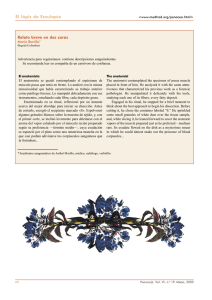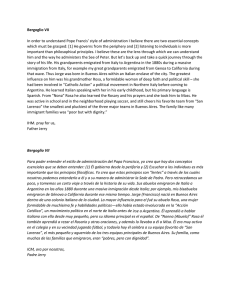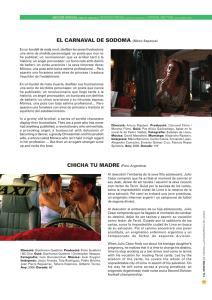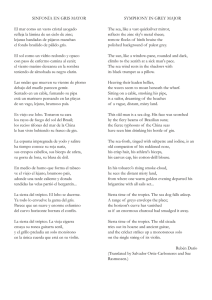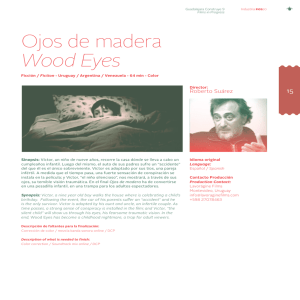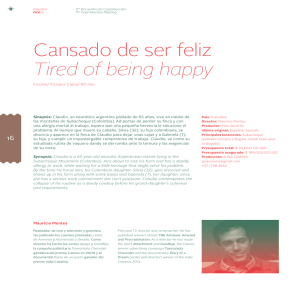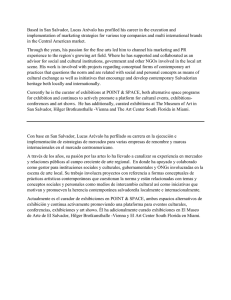THE STEBBINS GALLERY Among the private collections of pictures
Anuncio
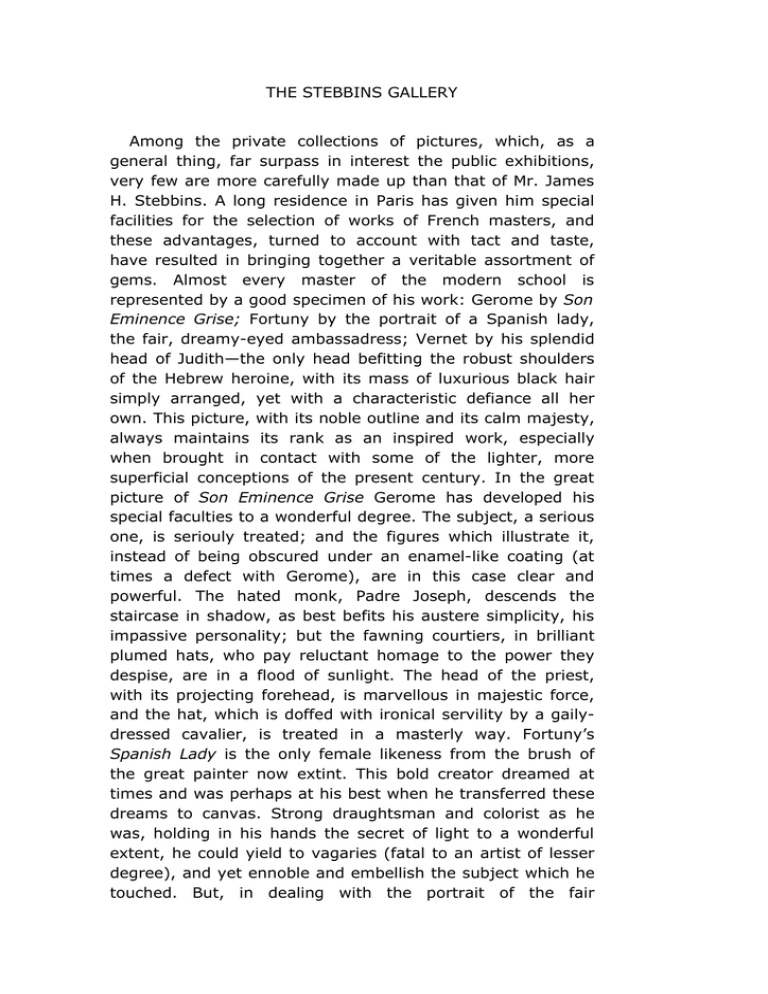
THE STEBBINS GALLERY Among the private collections of pictures, which, as a general thing, far surpass in interest the public exhibitions, very few are more carefully made up than that of Mr. James H. Stebbins. A long residence in Paris has given him special facilities for the selection of works of French masters, and these advantages, turned to account with tact and taste, have resulted in bringing together a veritable assortment of gems. Almost every master of the modern school is represented by a good specimen of his work: Gerome by Son Eminence Grise; Fortuny by the portrait of a Spanish lady, the fair, dreamy-eyed ambassadress; Vernet by his splendid head of Judith—the only head befitting the robust shoulders of the Hebrew heroine, with its mass of luxurious black hair simply arranged, yet with a characteristic defiance all her own. This picture, with its noble outline and its calm majesty, always maintains its rank as an inspired work, especially when brought in contact with some of the lighter, more superficial conceptions of the present century. In the great picture of Son Eminence Grise Gerome has developed his special faculties to a wonderful degree. The subject, a serious one, is seriouly treated; and the figures which illustrate it, instead of being obscured under an enamel-like coating (at times a defect with Gerome), are in this case clear and powerful. The hated monk, Padre Joseph, descends the staircase in shadow, as best befits his austere simplicity, his impassive personality; but the fawning courtiers, in brilliant plumed hats, who pay reluctant homage to the power they despise, are in a flood of sunlight. The head of the priest, with its projecting forehead, is marvellous in majestic force, and the hat, which is doffed with ironical servility by a gailydressed cavalier, is treated in a masterly way. Fortuny’s Spanish Lady is the only female likeness from the brush of the great painter now extint. This bold creator dreamed at times and was perhaps at his best when he transferred these dreams to canvas. Strong draughtsman and colorist as he was, holding in his hands the secret of light to a wonderful extent, he could yield to vagaries (fatal to an artist of lesser degree), and yet ennoble and embellish the subject which he touched. But, in dealing with the portrait of the fair ambassadress, he has found Nature too lavish in her gifts to be treated otherwise than with studied consideration. From a sombre background emerges a sweet face, flooding the dark canvas with soft, clear light—the only relief from the darkness, which belongs to the lady’s dress, to her eyes and her hair. A water-color by Fortuny, the Piferrari, is also found in this collection. An Italian is seated, pipe in hand, the contour of whose form is so powerfully delineated that, under the drapery which conceals it, one divines its symmetrical lines. Louis XIV Breakfasting with Moliere is another well-known picture by Gerome. The poet is seated at table, smiling graciously, but with becoming humility, as though a little embarrassed at these unwonted honors. The King is vulgar in type—unjustly so—since this particular defect was not conspicuous in the great monarch. The faces of the courtiers in the background are expressive of mild contentment, save that of a cavalier who, shrouded from royal observation, indulges in derisive laughter, and that of a prelate—the only vigorous conception of the whole—whose general bearing indicates disapproval and defiance. Gerome has treated his subject somewhat after the manner of Watteau— prettily, but not grandly—and in a work where he could have distinguished himself, he has not risen above mediocrity. Rico, a worthy successor of Fortuny’s in effects of sunlight, is represented by An Interior Court of Granada. The white houses of Andalusia, with their narrow, high windows and flowers standing without in broken clay pots, are faithfully portrayed. Two or three handsome women sit in the doorway, busied with their knitting and a little girl (the best of the figures) idly gazing at them, completes the picture. Dead white walls are very difficult to paint. Monotony crushes out inspirations; but in this Interior the eaves throw a warm shade over the dull wall, crevices here and there break its uniformity, and clinging parasites are pendant from its glistening surface. Another masterpiece of his collection is the Temptation of St. Anthony, by Beaumont. The subject is far from uncommon; but of the many artists who have treated it after their own manner, none have so successfully coped with its dificulties as Beaumont. Few recent conceptions unite such pure coloring and transparency of light with such wild yet thoughtful fancies. The unhappy saint hides his face in terror, as evil spirits of every description dance around him. Bacchus, mounted on a wild boar, his brow encircled with vine leaves, strikes the flanks of the animal with his knotty legs. But from this grotesque spectacle the eye turns willingly to the vision of beauty which fills the centre of the picture. The reclining form of a young and lovely woman, such as hasheesh-eaters might behold in their most entrancing dreams, is the last and worst temptation which assails the tortured man and from which he shrinks in holy horror. Vibert gives us the benefit of his travels through Spain, in a Scene at a Spanish Diligence Station. Spain, the land of moonlight adventures, of guitars and serenades, has evidently excited the French imagination to a degree, which causes the artist to take a somewhat distorted view of Spanish life in a diligence station. It would be unnatural to encounter so atractive a woman under such circumstances, or such carefully dressed young men, or bullfighters so richly clad. Yet could all artists dream as happily as Vibert, the world would be richer in good pictures. The hat of the priest, who sits on a stone bench calmly reading, is of a kind never used in travelling. But apart from these anachronisms and the disproportioned figure of a servant in the foreground of the picture, the work is one of the strongest, most animated and graceful in the collection. Zamacois suffers nothing from his brilliant surroundings. His Court Fool is a glowing bit of color. Seated on a bed, dressed as Mephistopheles in red, the Jester plays a guitar. A sunbeam flashing through the window envelops the shabby room, the figure of the man, the bed and the carpet, in one blaze of fire. Bouguereau’s picture, Hesitating between Love and Rich, is in direct contrast with this work of Zamacois. The three figures comprising the picture are disproportionalety large for the canvas. A handsome youth lays his heart and accompanying poverty at the feet of a young girl, who hesitates between love—as personified by the lad in question —and riches in the person of an elderly gentleman, somewhat too suggestive of Titian’s and Da Vinci’s old men, to pass for an original conception. The picture shows careful study without inspiration. It has color, but lacks proportion, action and expression. The skilled painter is visible in the work, but not the student of nature. Meissonier, whose chief merit is individuality, is always seen at his best when he is not striving to emulate Albert Durer, or to invest a petty subject with the vigor of Michael Angelo. The Game Lost and The Story of the Campaign are both admirable achievements in respect to light and color, the consummate master of luminary effects having surpassed himself in the treatment of the soldiers in the last named picture. Meissonier is the genius of form, not of conception. Soldiers and horses are his specialty. In The Captain of the Guards, another of his contributions to this excelent gallery, he gives his own portrait in a soldiers’s dress. Alma Tadema has a prominent place amongst these gems with his Queen Clotilde, wife of Clovis, Instructing her Children in the Use of Arms. The figure of the Queen lacks life and vitality, her eyes are inespresive, and the effect produced is that of a Catholic image rather than that of a woman. The coloring of the picture is yellowish and monotonous in tone. Detaille, whose Lancers enjoys a world-wide reputation, has not been eminently successful in his Scene in the FrancoGerman War. White clouds suggestive of cotton buds cross thesky in unpleasant proximity to the heads of the soldiers. Troyon contributes an admirable Castle in Normandy, and Bierstadt a magnificent Sunset in the Yosemite Valley. In his treatment of a subject Bierstadt recalls Velasco, the Mexican painter. Blue, black, red and yellow are found strongly mingled in this sunset, but in no more dazzling confusion than is natural in such climes. The artist wields a powerful brush, and would doubtless succeed in depicting the burning sands and saffron sky of Egypt. Jacomin’s picture of Faust and Mephistopheles, though remarkable in respect of modeling and coloring, is too commonplace in treatment to illustrate so lofty a theme. Mephistopheles, who resembles an old Heidelberg student, could hardly possess sufficient powers of seduction to move Faust’s superior soul; and the Doctor himself, who seems but an easy-going, good-natured creature, is certainly not the ardent being consumed by an inextinguishable fire that Goethe has introduced to us. Lack of space forbids especial notice of all that demands attention in this delightful collection of pictures; but enough has been said to indicate to the true lover of art that no gallery is richer in valuable paintings than that of Mr. Stebbins. The Hour, NuevaYork, 17 de abril de 1880 [Mf. en CEM] LA GALERÍA STEBBINS (Traducción) Entre las colecciones privadas de cuadros, que generalmente suelen ser más interesantes que las exposiciones públicas, muy pocas están tan bien formadas como la del señor James H. Stebbins. Su larga residencia en París le ha dado facilidades, aprovechadas con tacto y buen gusto, que han resultado en la reunión de un verdadero surtido de joyas artísticas. Casi todos los maestros de la escuela moderna están representados por buenas muestras de su trabajo: Gérôme por La Eminencia Gris; Fortuny por el retrato de una dama española, bella embajadora de ojos soñadores; Vernet por la espléndida cabeza de Judit—la única cabeza a tono con los hombros robustos de la heroína hebrea, con su mata de voluptuosa pelo negro sencillamente peinado, y sin embargo con todo su característico desafío. Este cuadro, con su noble conjunto y su serena majestad, siempre mantiene su mérito como una obra inspirada, especialmente al ponerse en contacto con algunas de las producciones más ligeras y más superficiales del siglo actual. En su gran cuadro La Eminencia Gris, Gérôme ha desarrollado sus facultades especiales a un grado maravilloso. El tema, serio, está tratado seriamente: y las figuras que lo ilustran, en vez de oscurecerse bajo una capa como de esmalte (que es a veces el defecto de Gérôme), en este caso están claras y fuertes. El odiado monje, el padre José, baja la escalera sombreada, tal cual corresponde a su austera sencillez, a su personalidad impasible; pero los cortesanos aduladores, con sus emplumados sombreros multicolores, rindiendo de mala gana homenaje al poder que odian, están de pleno en el sol. La cabeza del cura, con su levantada frente, es maravillosa en su fuerza majestuosa, y el sombrero quitado con servilismo irónico por un caballero alegremente vestido, está pintado por mano maestra. La Señora española, de Fortuny, es el único retrato de mujer del pincel del gran pintor fallecido. Este audaz creador soñaba a veces y quizás sus mejores trabajos los ejecutaba cuando llevaba sus sueños al lienzo. Acabado dibujante y colorista como era, poseedor en sus manos del secreto del dominio de la luz hasta extremos maravillosos, podía ceder a caprichos (cosa fatal en un artista de menor categoría), y, sin embargo, ennoblecer y embellecer lo que pintaba. Pero al hacer el retrato de la bella embajadora, ha encontrado a la Naturaleza demasiado pródiga en sus dádivas para ser tratada de otro modo que no sea con estudiado cuidado. De un fondo sombrío surge un dulce rostro, inundando el oscuro lienzo de una suave luz clara—el único contraste con la oscuridad, que pertenece al vestido, los ojos y el pelo de la dama. Una acuarela de Fortuny, Piferrari, también se encuentra en esta colección. El cuadro representa a un italiano sentado con una pipa en la mano cuyo cuerpo está tan bien delineado, que bajo los pliegues de las ropas, se adivina la perfecta simetría de las líneas. Luis XIV desayunando con Molière es el otro cuadro bien conocido de Gérôme. El poeta está sentado a la mesa, sonriendo graciosamente, pero con humildad conveniente, como si estuviera algo turbado por estos honores inesperados. El rey es de tipo vulgar—injustamente—ya que el gran monarca no tuvo ese defecto. Las caras de los cortesanos al fondo expresan regular contento, con la excepción de un caballero que sin ser visto por el rey se ríe a mandíbula batiente, y la de un prelado—la única concepción vigorosa del cuadro—que en todo su porte indica desaprobación y desafío, Gérôme ha pintado la escena algo a manera de Watteau—bonita, pero sin grandeza—y en este cuadro donde se podía haber distinguido, no ha pasado de lo mediocre. Rico, un digno sucesor de Fortuny en los efectos de la luz del sol, está representado por Un patio de Granada. Las blancas casas de Andalucía con sus estrechas ventanas altas y flores afuera en rotos jarrones de barro están fielmente retratados. Dos o tres hermosas mujeres, sentadas en la portada tejiendo, y una pequeña niña (la mejor de las figuras) mirándolas con pereza, completan el cuadro. Blancas paredes sin adorno son difíciles de pintar. La monotonía destruye la inspiración; pero en este “interior” las alas del tejado dejan caer una sombra fuerte sobre la pared desnuda, grietas aquí y allá rompen su uniformidad, y enredaderas colgantes se deslizan por la superficie resplandeciente. Otra obra maestra de la colección es La tentación de San Antonio, por Beaumont. El asunto está lejos de ser raro; pero de los muchos artistas que lo han pintado a su manera, ninguno ha vencido sus dificultades con tanto éxito como Beaumont. Pocas obras recientes unen un colorido tan puro y tanta transparencia de luz con tan desenfrenada y, sin embargo, pensadora imaginación. El infeliz santo, esconde su cara aterrorizada, mientras espíritus malignos de todas clases bailan en su derredor. Baco, montado sobre un jabalí, su frente adornada de pámpanos, aprieta los flancos del animal con sus piernas nudosas. Pero de este espectáculo grotesco los ojos se dirigen gustosos a la visión de belleza que llena el centro del cuadro. La figura recostada de una joven y hermosa mujer, tal como los narcómanos pudieran contemplarla en sus sueños más delirantes, es la última y la peor tentación que asalta al torturado hombre, de la cual huye con santo horror. Vibert nos representa sus viajes por España en una Escena en una estación de posta española. España, la tierra de aventuras a la luz de la luna, de guitarras y serenatas, evidentemente ha despertado la imaginación francesa a tal extremo, que causa que el artista interprete de una manera algo errónea la vida española en una estación de posta. Sería poco corriente encontrar una mujer tan atractiva en semejante ambiente o jóvenes vestidos tan cuidadosamente o toreros de traje tan fastuoso. Sin embargo, si todos los artistas pudieran soñar tan felizmente como Vibert, el mundo estaría más rico de buenos cuadros. El sombrero del cura que lee tranquilamente sobre un banco de piedra, es de la clase que nunca se lleva de viaje. Pero aparte de estos anacronismos y de la figura desproporcionada de un sirviente en primer término en el cuadro, la obra es una de las más fuertes, más animadas y más graciosas de la colección. Zamacois no se perjudica en nada por esta vecindad brillante. Su Bufón de la corte es un luminoso pedazo de color. Sentado sobre una cama, vestido en escarlata como Mefistófeles, el bufón toca una guitarra. Un rayo de sol cayendo por la ventana envuelve el miserable cuartucho; la figura del hombre, la cama y la alfombra son una llama de fuego. El cuadro de Bouguereau, Vacilando entre el amor y la riqueza, está en abierto contraste con la obra de Zamacois. Las tres figuras que componen este cuadro se encuentran en gran desproporción con el tamaño del lienzo. Un hermoso joven pone su corazón y su pobreza a los pies de una muchacha, que vacila entre el amor—personificado por el mozo en cuestión—y la riqueza representada por un caballero anciano, demasiado parecido a los viejos de Tiziano y de Da Vinci, para pasar por una concepción original. El cuadro revela cuidadoso estudio sin inspiración. Tiene color, pero carece de proporción, de vida y de expresión. El artista acabado, pero no el conocedor de la naturaleza, está visible en esta obra. Meissonier, cuyo mayor mérito es la individualidad, siempre se muestra mejor cuando no busca emular a Alberto Durero, o trata de dar a un asunto pequeño el vigor de Miguel Ángel. El juego perdido y La historia de la campaña son dos obras admirables en cuanto a la luz y el colorido, pues el maestro consumado de efectos de luces se ha aventajado a sí mismo al pintar a los soldados en el último cuadro mencionado. Meissonier es el genio de la forma, no de la concepción. Soldados y caballos son su especialidad. En El capitán de la guardia, otra de sus obras en esta excelente colección, presenta su propio retrato en uniforme de soldado. Alma Tadema ocupa un puesto prominente entre estas joyas con su cuadro La reina Clotilde, esposa de Clodoveo, enseñándole a sus hijos cómo usar las armas. La figura de la reina carece de vida y de vitalidad, sus ojos son inexpresivos y produce más el efecto de una imagen católica que el de una mujer. El colorido del cuadro es amarillento y de tono monótono. Detaille, cuyos Lanceros gozan de fama mundial, no ha sido afortunado en su cuadro Escena de la guerra francoprusiana. Blancas nubes que parecen bolas de algodón pasan por el cielo en proximidad desagradable sobre las cabezas de los soldados. Troyon presenta un admirable Castillo en Normandía, y Bierstadt una magnífica Puesta de sol en el valle de Yosemite. Bierstadt recuerda en su manera de pintar a Velasco, el pintor mexicano. Azul, negro, rojo y amarillo se encuentran fuertemente mezclados en esta puesta de sol, pero en una confusión no menos deslumbrante de lo corriente en tales climas. El artista maneja un vigoroso pincel y pudiera indudablemente lograr reproducir los arenales candentes y el cielo azafrán de Egipto. El cuadro de Jacomin, Fausto y Mefistófeles, aunque notable en cuanto al modelado y el colorido, está pintado demasiado vulgarmente para representar un asunto tan elevado. Mefistófeles, que parece un viejo estudiante de Heidelberg, apenas podría poseer los dones de seducción suficientes para mover el espíritu superior de Fausto; y el Doctor en sí, que parece un ser despreocupado y bondadoso, ciertamente no es el hombre exaltado, consumiéndose por el fuego inextinguible, que nos describió Goethe. Falta de espacio no nos permite hacer mención especial de todo lo que merece atención en esta preciosa colección de cuadros: pero se ha dicho bastante para indicarle al verdadero amante del arte que no hay ninguna galería más rica en cuadros valiosos que la del señor Stebbins.

